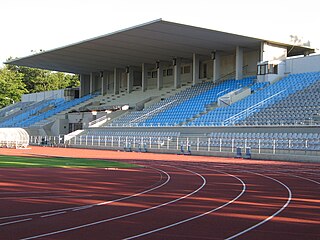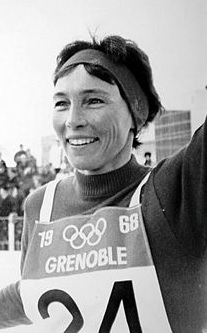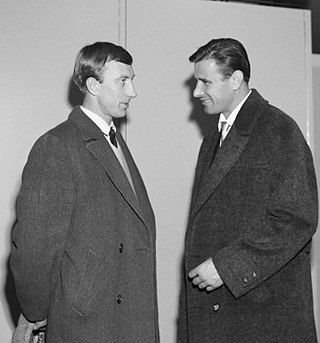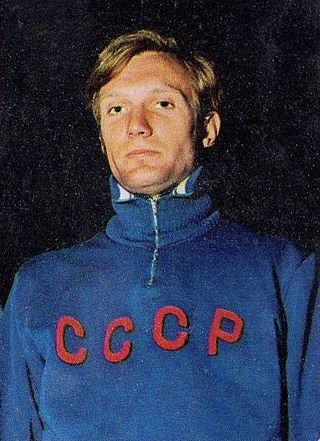Related Research Articles

Paul Keres was an Estonian chess grandmaster and chess writer. He was among the world's top players from the mid-1930s to the mid-1960s, and narrowly missed a chance at a World Chess Championship match on five occasions. As Estonia was repeatedly invaded and occupied during World War II, Keres was forced by the circumstances to represent the former Soviet Union and Nazi Germany (1941–44) in international tournaments.
The recorded history of music in Estonia dates back as far as the 12th century.

Meistriliiga is the highest division of the Estonian Football Association annual football championship. The league was founded in 1992, and was initially semi-professional with amateur clubs allowed to compete. With the help of solidarity mechanisms, the league is fully professional since the 2020 season.

Novuss is a two-player game of physical skill which is closely related to carrom and pocket billiards. Novuss originates from Estonia and Latvia, where it is a national sport. The board is approximately 100 centimetres (39 in) square, typically made of wood, has pockets in each corner, and lines marked on the surface. The board is usually placed on a stand, but may be placed on a barrel or other surface that allows the pockets to hang down properly. It uses small discs instead of balls, and each player has a small puck instead of the cue ball used in other cue sports. Players use a small cue stick to propel their pucks into their colored object discs, knocking them into the pockets. The winner is the first one to sink all eight of their object discs.

The Kadriorg Stadium is a multi-purpose stadium in Tallinn, Estonia. Opened in 1926, it is one of the oldest stadiums in Estonia. It is currently used mostly for track and field competitions, but also serves as a home ground for JK Tallinna Kalev. The stadium holds 5,000. The Kadriorg Stadium is located about 2 km east of the city centre in the subdistrict of Kadriorg near the Kadriorg Palace. The address of the stadium is Roheline aas 24, 10150 Tallinn.

Alevtina Pavlovna Kolchina was a Soviet cross-country skier who competed during the 1950s and 1960s for Burevestnik and later for Dynamo sports societies. She competed in four Winter Olympics, earning a total of five medals. Kolchina also competed several times at the Holmenkollen ski festival, winning three times at 10 km (1961–1963) and once at 5 km (1966).

Iivo Nei is an Estonian chess master.

Igor Aleksandrovich Netto was a Soviet footballer, considered one of the greatest Soviet players ever. He started out playing on the left of defense but, due to his offensive mentality, dribbling and technical abilities turned into a dynamic central midfielder. His versatility and footballing intelligence allowed him to play a number of positions across defense and midfield.

Jüri Tarmak was an Estonian high jumper who competed for the Soviet Union.
Leho Laurine was an Estonian chess master.
The Korvpalli Meistriliiga, known as the OlyBet Korvpalli Meistriliiga for sponsorship reasons, is the highest tier level and most important professional basketball league in Estonia. It is controlled by the Estonian Basketball Association.
Tõnno Lepmets was an Estonian professional basketball player, who competed for the Soviet Union. He won gold with the Soviet basketball team at the 1963 and 1967 EuroBasket. Elected to the Hall of fame of Estonian basketball in 2010. He was he long-time center of Estonian national team.
Jaak Lipso is a retired Estonian professional basketball player, who competed for the Soviet Union. He is the only Estonian basketball player who has won two medals at the Olympic Games. Lipso has also won two medals at the FIBA World Championship and he is a three-time Eurobasket champion with the Soviet Union national basketball team. He was a member of the Soviet Union national team from 1961 to 1970. After his active career Lipso became a basketball coach. Elected to the Hall of fame of Estonian basketball in 2010.
Priit Tomson is a retired Estonian professional basketball player, who competed for the Soviet Union. He is the only Estonian basketball player who has won two gold medals at the World Championship. Tomson is a three-time Eurobasket champion with the Soviet Union national basketball team. He was a member of the youth and student teams of the Soviet Union in 1963–65 and the senior team in 1966–74 as a small forward. The highest-scoring player in the Estonian National Team throughout his long career.He was described as a basketball aristocrat, who was characterised by skilful operating in picking up offensive rebounds and accurate throwing from central positions and was often tasked with neutralising the opponents’ most dangerous players. Elected to the Hall of fame of Estonian basketball in 2010.

TalTech Basketball is the basketball team of Tallinn University of Technology based in Tallinn, Estonia. The team plays in the Latvian–Estonian Basketball League. Their home arena is the TalTech Sports Hall.
Sport plays an important role in Estonian culture. Estonia first competed as a nation at the 1920 Summer Olympics, although the National Olympic Committee was established in 1923. Estonian athletes took part at every Olympic Games until the country was annexed by the Soviet Union in 1940. The 1980 Summer Olympics sailing regatta was held in the capital city Tallinn. Estonia has won most of its Olympic medals in wrestling, athletics, weightlifting, and cross-country skiing.
Maaja Ranniku was an Estonian chess player.

Toomas Leius is a former tennis player from Estonia who competed for the Soviet Union.
Gunnar Uusi was an Estonian chess player who won the Estonian Chess Championship six times.

The Estonian Indoor Athletics Championships is an annual indoor track and field competition organised by the Estonian Athletic Association, which serves as the national championship for the sport in Estonia. First held in 1963, the competition was established during the period of Soviet occupation, thus was limited to a sub-national scope for the Estonian Soviet Socialist Republic, as Estonia's athletes still competed at the national Soviet Indoor Athletics Championships. The Estonian Indoor Championships became the undisputed official national-level event for Estonia in 1992, following the dissolution of the Soviet Union.